After years of wondering, I finally made the switch from my old PC based setup. So, does Garageband iPad live up to the hype?
Garageband iPad: The Positives
No more file storage issues
Purchasing the 32GB iPad forced me down the cloud storage road for the first time. This is a good thing as it keeps your DAW device clean of the clutter of multiple project files, which optimises performance. I decided on Google Drive, with the iPad interface making uploading and downloading relatively simple.
Of course, cloud storage is an option on just about any DAW, but I’ll still give a point to Garageband iPad for necessitating it.
The slickest of interfaces
Garageband is the best looking DAW I’ve ever come across, which helps with the process of producing in no small way. It’s just a joy to use. Logical, intuitive. Different types of instruments are colour-coded, icons are provided for tracks, plus there’s the wow factor of the instruments themselves.
It reeks of Apple’s famous quality and gives you confidence in the package.
Let’s not forget the touch-screen aspect which lends a more organic, fun, gaming feel to the whole experience. Indeed, user experience seems to be Garageband iPad’s calling card.
The Drummer
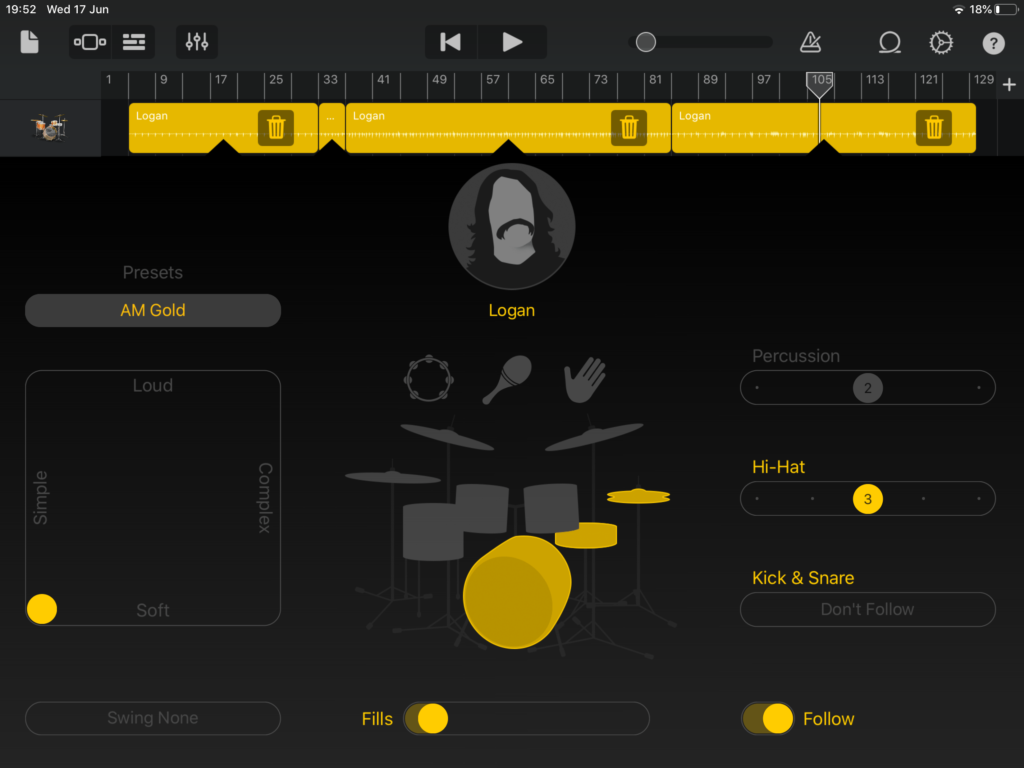
My first port of call, and after years of wrestling with keyboards, stand-alone drum machines, the BOSS BR series, and many a drum plug-in including Toontrack EZ-drummer, XLN Audio Addictive Drums, and Steinberg Groove-Agent, my conclusion is that Garageband Drummer is the best by some margin.
The first advantage is the direct, seamless integration with Garageband, no issues with installation, activation keys, or performance here.
Next, it sounds amazing. As good as, if not better than anything I’ve heard.
But the most crucial aspect for me is having instant access to a wide range of kits, styles, and variations (including fills) while making it easy to access and adapt them to your song. Garageband covers all the bases here, with its line-up of virtual drummers from a number of different genres, making it ridiculously simple to create even the most complex of arrangements.
If that wasn’t enough, Garageband gives you two other virtual drum options: Beat Sequencer; using the familiar old-school grid pattern and Smart Drums, which adds another layer of intuitive automation over the top of your basic grid.
Bottom line: Garageband features the most comprehensive, powerful yet user-friendly collective of drum apps, straight out of the box, and all of the samples sound fantastic.
The Touch / Smart Instruments.
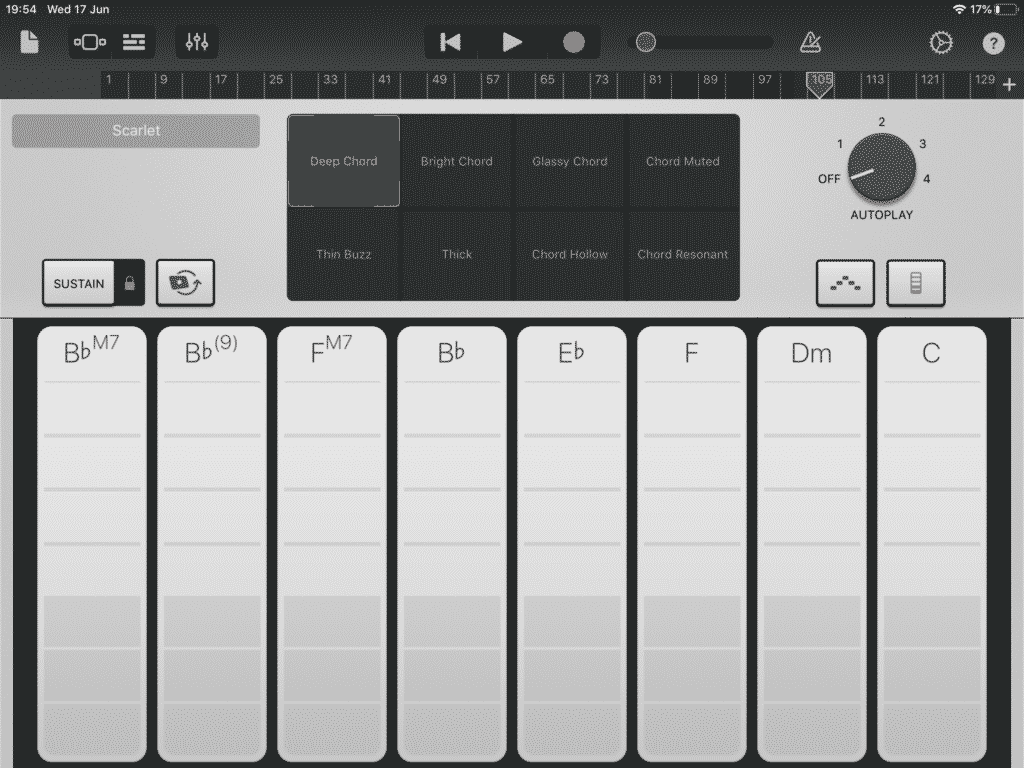
Similar to the show-stopping Drummer instrument, the Touch / Smart instruments make it simple to put together tracks with very little effort. Personally I’ve made the most use out of the Bass and Keyboards.
Once again the sound library is huge out of the box and Garageband gives you a number of ways to approach a track. A great feature is the ability to set up the key and chords of your song, making accompaniment easy and fun. Autoplay will suggest basslines/keyboard riffs for you, you can choose to play from scales or chords, or you can play in realtime using a variety of touch-keyboard configurations.
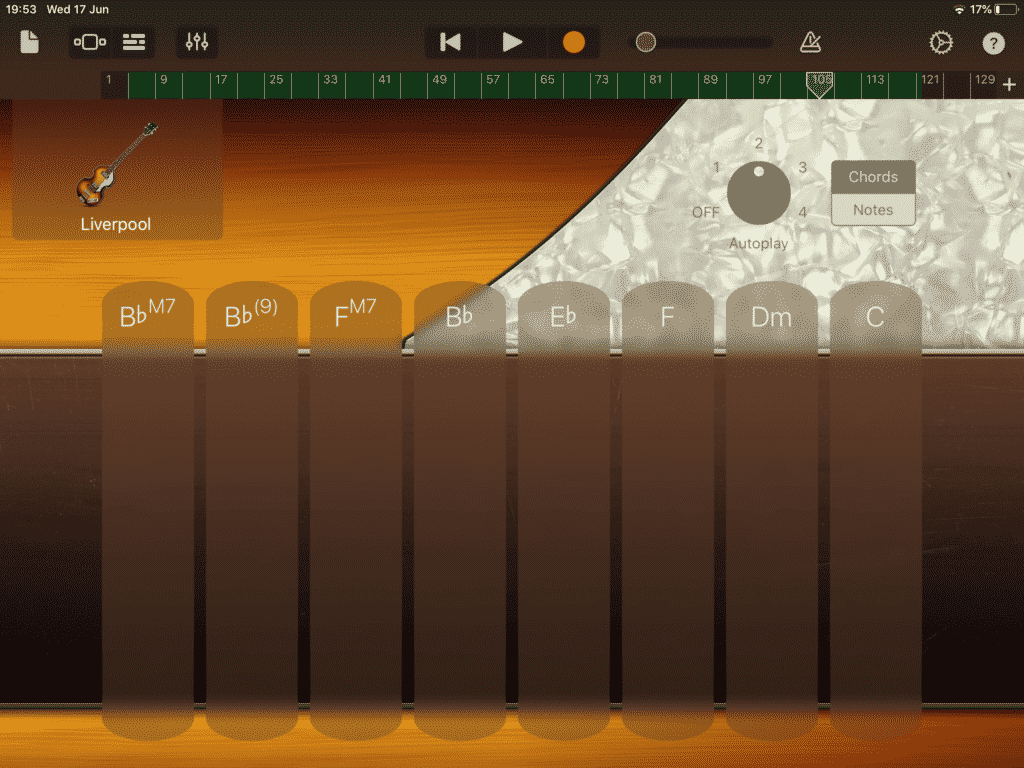
The choice is yours, and Garageband gives you just about all of them.
More than that, it’s just a great way to while away a few hours.
It’s easy to get a great guitar sound
This was my biggest concern, moving from a zero-latency setup of my BOSS BR-800 into Ableton Live. I’ve spent months of my life figuring out the best way of recording decent guitar sounds direct (micing up isn’t an option).
I did some research beforehand, and yes, you will need a guitar interface of some sort to record electric guitar in Garageband for iOS.
The good news is they’re readily available, and won’t break the bank. I chose the TC Helicon Go Guitar which is an entry-level interface specifically designed for iOS devices and retails at only £20.
The great thing about the iPad is the headphone socket doubles as an input, meaning devices like the Go Guitar (a cheaper alternative to the iRig) can connect with this single port without needing power.
So, with some trepidation I plugged in… and once again Garageband delivers!

Although it has to be said, there is some latency, it’s manageable, and it’s not long before your playing adapts to it.
If you’re happy to make the investment, there are better performing interfaces out there. Both guitar only (The iRig HD2 for example), through to dedicated USB devices like the Focusrite Scarlett series, all the way up to the pristine all-singing/all-dancing world of Apogee.
There is also more comprehensive, lower latency and better-sounding guitar software out there from the like of Amplitube.
For me, I tried the free versions of Amplitude and Bias FX and, although the core sounds and latency beat Garageband (particularly in Amplitubes case), the gap isn’t wide enough to compensate for the lack of effects and options.
The way I see it, I’ve already made a substantial investment in the iPad and I’m more than happy with the Garageband Guitar amp. This is a one-stop solution to any electric guitar sound you’ll ever need, and a whole lot less hassle than my old setup.
Garageband guitar amp gives you access to all the expected amp models from Fenders, Marshall, Orange, Vox, Mesa plus a few others.
Effects are more stripped-down but it’s nice to see a treble booster in there to go with the Vox for some Brian may like tones.
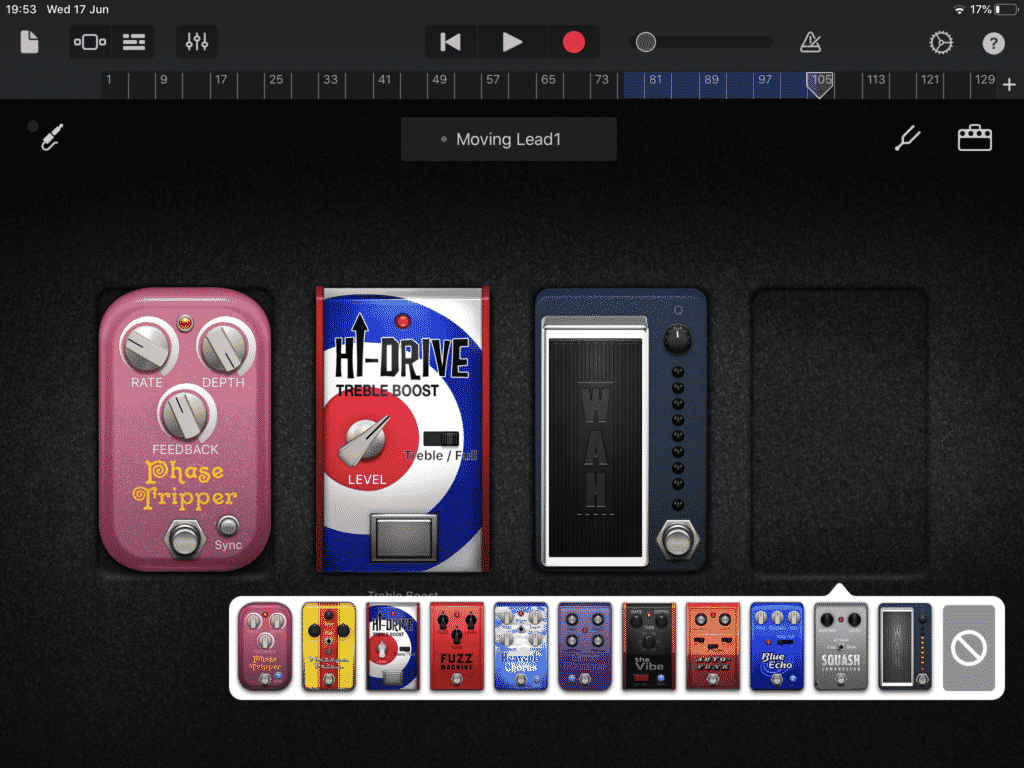
Presets are also reasonably catered for and give a great idea into how combinations of amp and pedals work for your own presets. Stand out: ‘Moving lead’, a thick slice of overdriven swirling phase.
Stacking the overdrive, boost, and/or fuzz seems to be the route to the biggest tones, they interact really well with each other.
I’ve forgotten about Amplitube already.
‘Autotune’ comes as standard
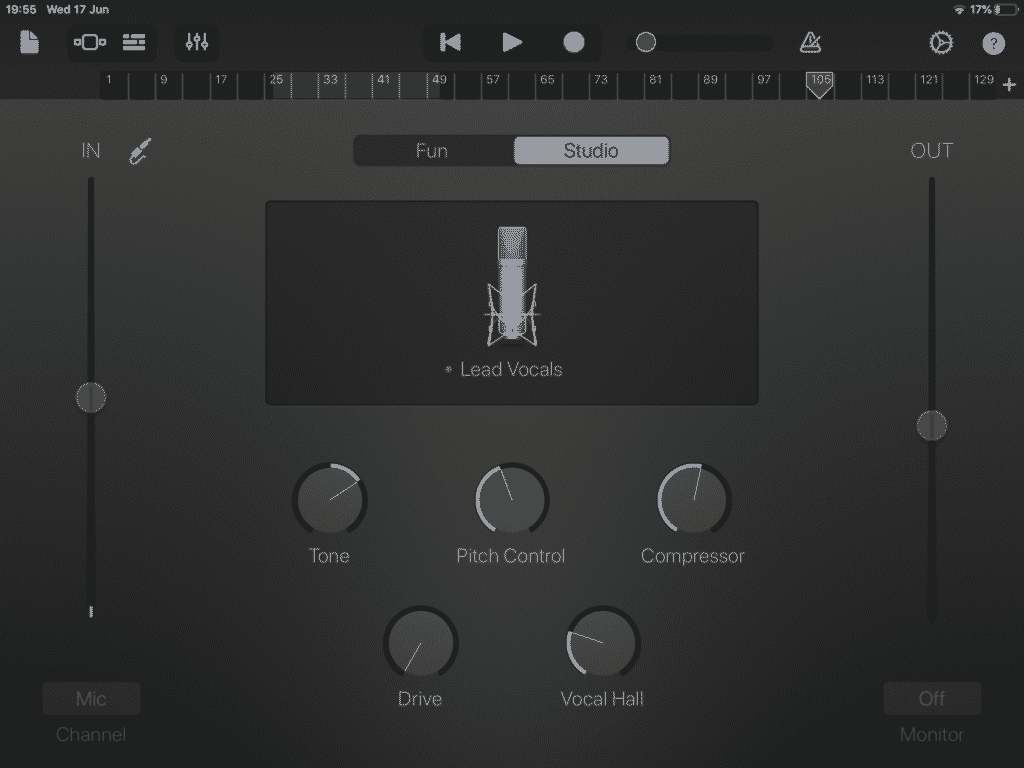
I need Autotune. Not to correct mistakes (I’d rather do another take for that) but as an indispensable vocal sweetener. Garageband ‘Enhanced Tuning’ works, like many Garageband features, a lot better than you’d ever hoped.
Actually, in a head to head comparison. Garageband pitch control takes the key of the song as a reference and only gives you a single dial, while Autotune is a lot more complicated to set up for the same result.
Performance and sound quality are exceptional
Well, what can you say? Apple makes quality products. Even with the iPads 3GB of RAM and approaching the maximum 32 tracks, I saw no signs of a slowdown.
The much-debated ‘Optimizing Song’ message has started to appear on occasion, but I’ve noticed no sound degradation so I’ll assume this is Garageband’s way of clearing the song cache to increase performance.
This is a sleek machine, running software closely coupled to the operating system and with very few plugins needed. I like that.
The internal mics are great.
The internal condenser mic would be absolutely fine for recording quality vocal and acoustic guitar audio, providing all the level and clarity you’d need.
Noise is sometimes present but this can be dialed out with the noise gate.
Again, an outboard mic would be a wise investment. I decided on a Rode Videomic which works in the same way as the Go Guitar but the sky is the limit for mics if you wanted to invest.
It’s worth noting that the internal mic matches up to the Rode for clarity and volume, and only loses out on background noise (the Rode is a directional mic).
For live recording, the internal mic would actually work better as you have more than one sound source!
Expansion with downloadable content, including loops.
Garageband is extremely popular and well-supported, which is good news for downloadable content.
I’ve only just scratched the surface, but already download free content including guitar sounds and some awesome Latin-flavoured loops.
The take-away here is Garageband isn’t a closed, stale system. It’s a thriving, developing community with new content frequently becoming available.
And that’s a really good thing.
Convenience
My previous setup. An old PC, a keyboard, a mouse, mic, mic-stand, BOSS BR-800 as a USB audio interface.
My new setup: iPad. Rode VideoMic, TC-Helicon Go Guitar.
The Ipad is also wafer-thin, light as a feather, and designed to be portable. Enough said.
Garageband iPad: The Negatives
There’s no master track or mastering.
To be fair, not many DAWs (if any) feature their own fully-featured mastering track, but the lack of a basic master track is a glaring omission in Garageband.
Sure, the FX track is a workaround but this gives you a very limited set of features.
Previous I was using iZotope Ozone. That was perfect. Just assign it to the master track, select a present and bingo. Instant polish.
I purchased Final Touch by Positive Grid, an Ozone clone that gets me very similar results, it’s just you need to export your Garageband as .wav file into it, and exporting from it is even worse. Which leads me onto…
The file system is clunky.
The iPad is my first ever Apple product. Let’s cut to the chase. I hate the way its file system works! It’s just a pain and slows down your workflow.
First example? The ridiculously convoluted way apps communicate with each other. Take Garageband and Final Touch, an app designed for iOS and Garageband. So, to get a file into Final Touch, you first have to save it into Final Touch (not intuitive at all), you’re then prompted to export the project (best to have it in .wav format but why am I even asked?), then you wait ill the whole project exports…
.. then when you finally have your project in Final Touch and mastered it, the mastered files are stored in Final Touch, BUT NOT ACCESSIBLE OUTSIDE OF FINAL TOUCH!

Yep, the only way of getting your lovingly mastered track out of Final Touch is to export it to another app (e.g. DropBox). From there it’s still not straightforward, in the end, I emailed myself the file from DropBox.
True a lot of this could be the fault of the actual app, but I can’t see why a software company would intentionally build in these workarounds and complications.
Zipping up a Garageband project to store on Google Drive is a bit of pain too in that you can only compress files from the file system app as opposed to Garageband’s file browser.
All in all, navigating around the iPad’s clunky file system is frustrating and time-consuming.
There’s no auto-punch in/out looping.
Together with almost one-click mastering, the feature I miss most about my Ableton setup is the looping and auto-punch in/out.
It feels like Garageband for iPad’s transport feature’s have been deliberately reduced to push customers towards the full-fat Garageband for Mac (which also has a dedicated master track).
In practice, if you have a difficult section to record, you’ll need to manually reset your location pointer for each and every take, which gets boring very quickly.
Sections?
With Ableton (and many of its competitors) breaking up a track into sections was easy. Just drop in a location marker, label it, and away you go. This combined with the looping, auto-punching and other transport controls made navigation much quicker.
With Garageband iPad, we have ‘Sections’. These need to be added in advance before you can even start to put a track together, and also added in when increasing the song length.
There’s an auto-add feature, but, as you can probably tell by now, it’s not simple or intuitive, just annoying.
Lack of default styles.
Back in the halcyon days of my trusty Yamaha workstation keyboard, I had access to a massive library of backing rhythms for various styles. Songwriting wise, this just-add-water approach was, and still is the most inspiring (and fastest) way to put together music.
From there I moved to the more ‘blank canvas’ approach of DAWs and some of that creative spark was lost. I’ll admit I sometimes need that bit of a leg-up to at least get me started or suggest something out of my comfort zone.
With Garageband, the instruments and loops, although incredible, and a thousand times better then I’ve seen in any DAW, still fall short in that they lack a style library to flick through. Sure they can be automated by key, time signature, tempo, and even the chords and notes within, but I would’ve loved to just select ‘Rhumba’ and just get on with it as my old Yamaha could.
Conclusion
Producing music on Garageband for iPad is an absolute joy. Yes, it’s sometimes too simplistic and the file system frustrates but I can forgive that as, for the most part, this feels light-years ahead of just about anything both hardware and software-wise.
The lack of styles may be an unfair criticism given the benefits of having a whole orchestra of touch-instruments at your fingertips. After all, this is DAW, not a real-life Audio Workstation costing £5k+
I’ve upgraded as well as down-sized. All my apps bar one (Final Touch) are native to Garageband. I have a mic and Guitar interface which plug straight in without needing power or outboard gear. I have Google Drive as the ultimate hard disk.
So Yes, Garageband for iPad does live up to the hype, and then some.
It’s beautiful, slick, powerful, but most of all, fun.
Oh, and best of all, It’s absolutely FREE! (if you have an iPad).
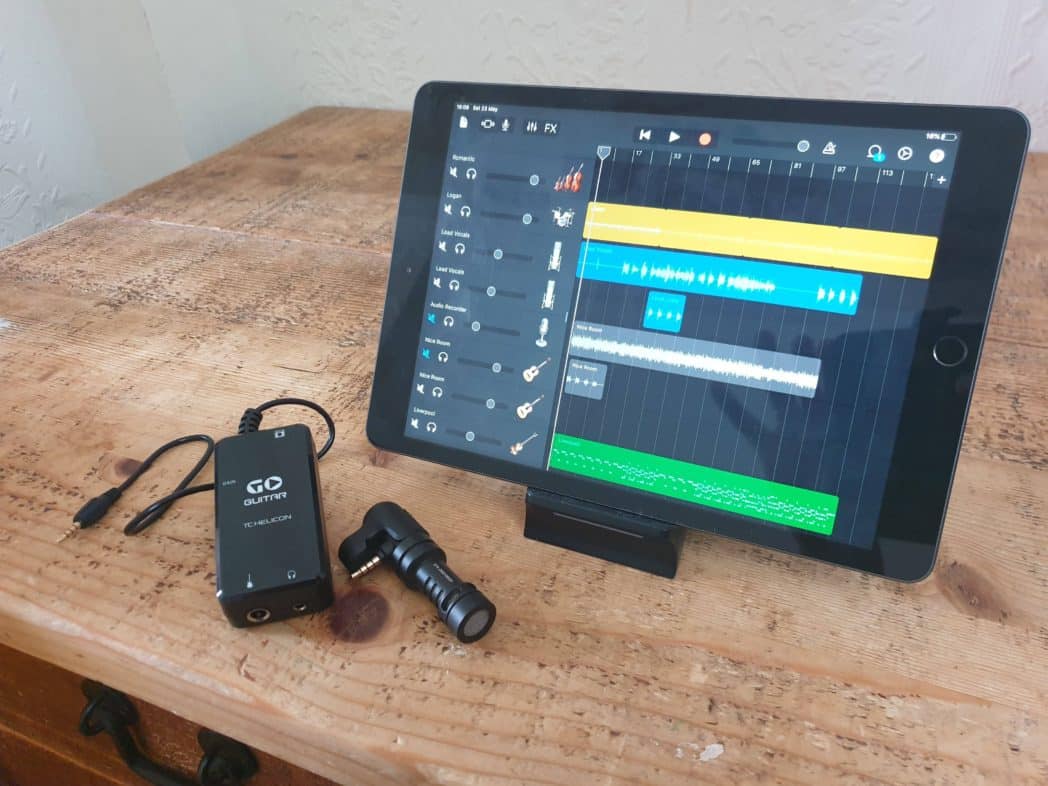
Leave a Reply